Patient Case Study: Nursing Management of Mr. Ferguson in the ED
VerifiedAdded on 2023/06/03
|9
|2775
|162
Case Study
AI Summary
This case study examines the nursing management of a 76-year-old male, Mr. Ferguson, who presented to the emergency department with chest heaviness and related symptoms. The study details the patient's presenting problem, focusing on the pathophysiological issues, reviews the pharmacokinetics and indications of prescribed medications such as Aspirin, Morphine Sulphate, Heparin, and Fentanyl. It also discusses appropriate nursing management strategies, including assessment techniques, oxygen implementation, and patient positioning, to mitigate adverse effects. Furthermore, the case study outlines the crucial information to be shared with the patient regarding drug interactions and long-term effects, emphasizing the importance of patient education for successful treatment and future health management. The analysis concludes with a summary of the medications' absorption, distribution, metabolism, and excretion processes, alongside potential drug interactions and their associated side effects, highlighting the comprehensive approach required in managing Mr. Ferguson's condition.
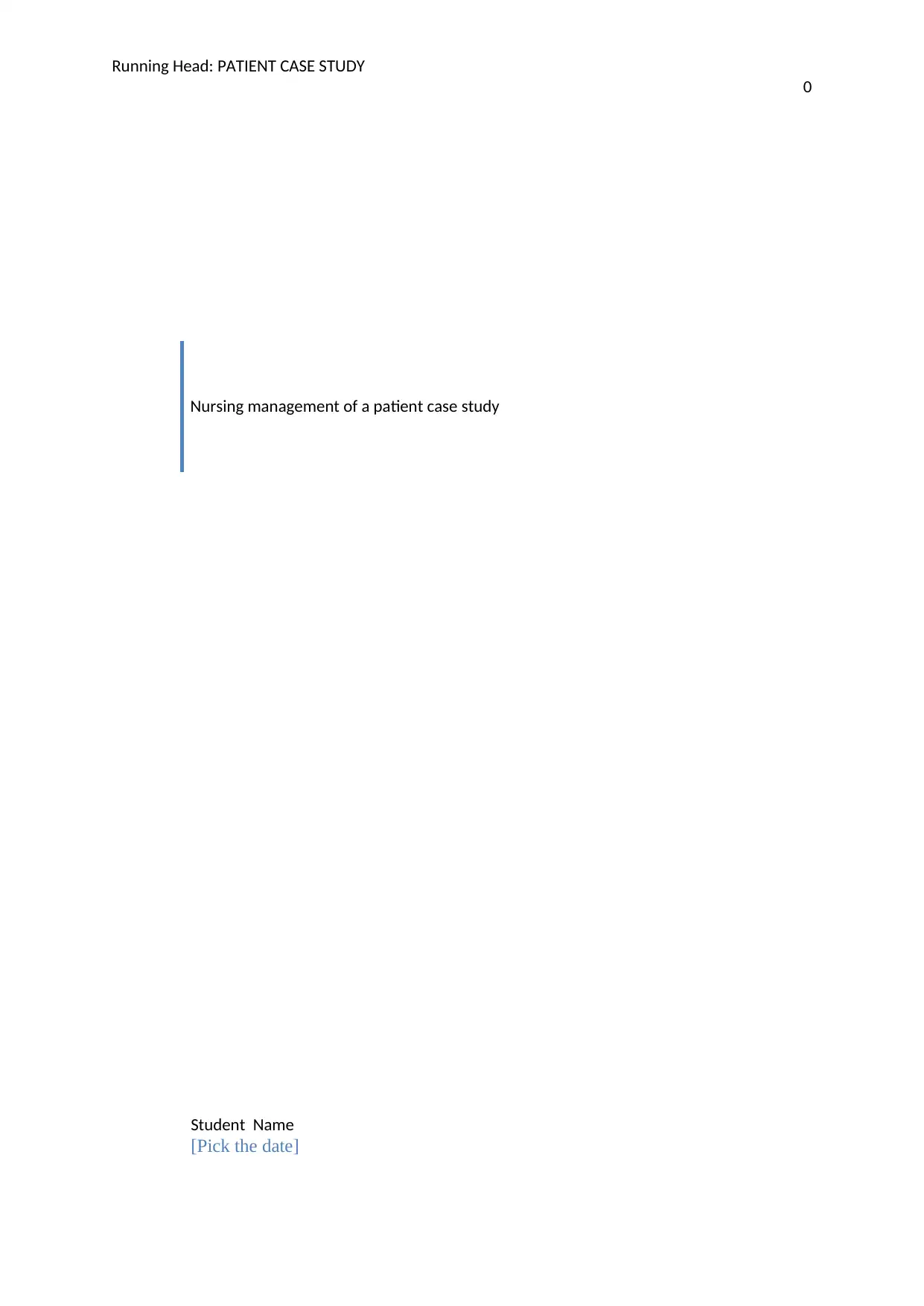
Running Head: PATIENT CASE STUDY
0
Nursing management of a patient case study
Student Name
[Pick the date]
0
Nursing management of a patient case study
Student Name
[Pick the date]
Paraphrase This Document
Need a fresh take? Get an instant paraphrase of this document with our AI Paraphraser
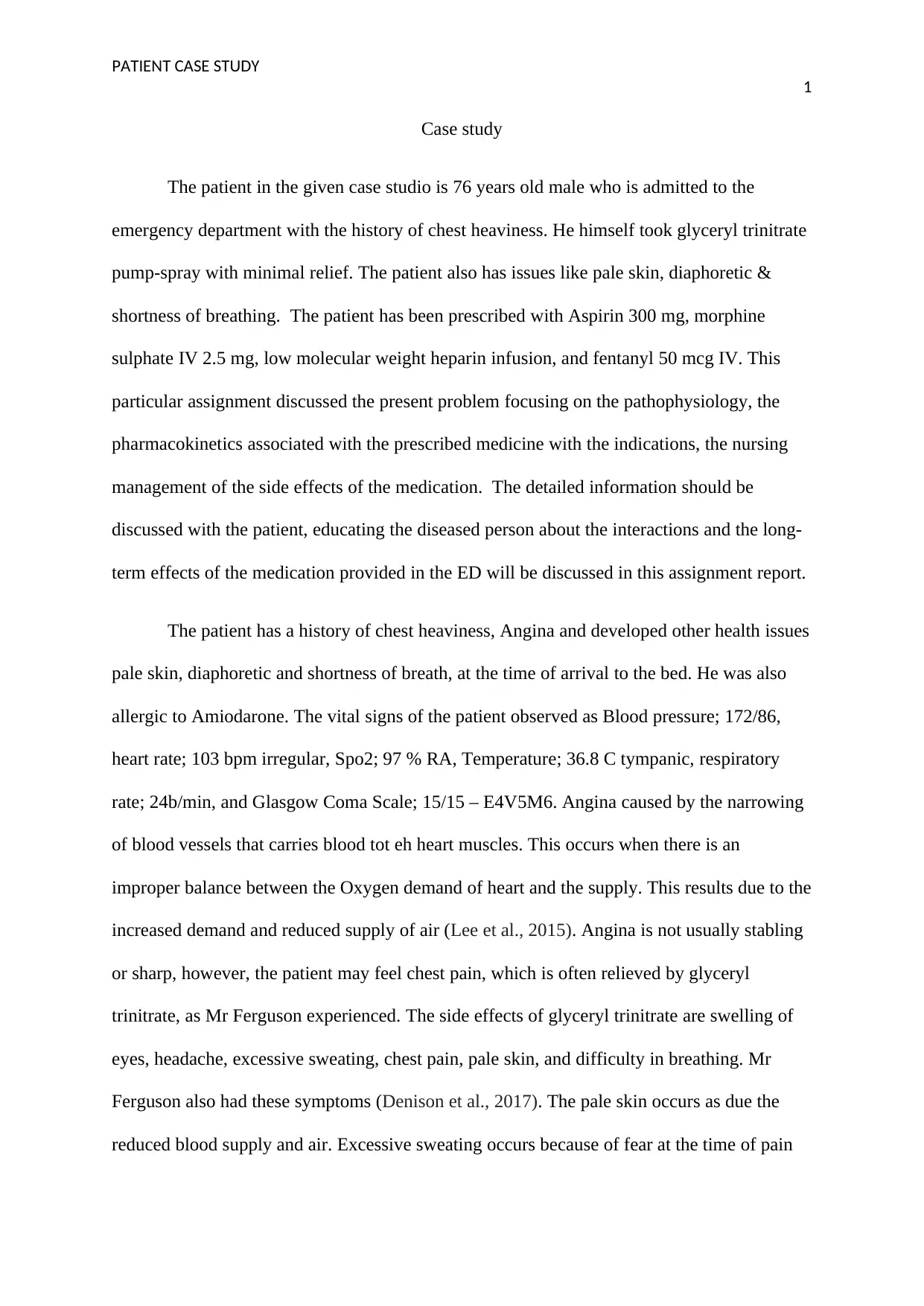
PATIENT CASE STUDY
1
Case study
The patient in the given case studio is 76 years old male who is admitted to the
emergency department with the history of chest heaviness. He himself took glyceryl trinitrate
pump-spray with minimal relief. The patient also has issues like pale skin, diaphoretic &
shortness of breathing. The patient has been prescribed with Aspirin 300 mg, morphine
sulphate IV 2.5 mg, low molecular weight heparin infusion, and fentanyl 50 mcg IV. This
particular assignment discussed the present problem focusing on the pathophysiology, the
pharmacokinetics associated with the prescribed medicine with the indications, the nursing
management of the side effects of the medication. The detailed information should be
discussed with the patient, educating the diseased person about the interactions and the long-
term effects of the medication provided in the ED will be discussed in this assignment report.
The patient has a history of chest heaviness, Angina and developed other health issues
pale skin, diaphoretic and shortness of breath, at the time of arrival to the bed. He was also
allergic to Amiodarone. The vital signs of the patient observed as Blood pressure; 172/86,
heart rate; 103 bpm irregular, Spo2; 97 % RA, Temperature; 36.8 C tympanic, respiratory
rate; 24b/min, and Glasgow Coma Scale; 15/15 – E4V5M6. Angina caused by the narrowing
of blood vessels that carries blood tot eh heart muscles. This occurs when there is an
improper balance between the Oxygen demand of heart and the supply. This results due to the
increased demand and reduced supply of air (Lee et al., 2015). Angina is not usually stabling
or sharp, however, the patient may feel chest pain, which is often relieved by glyceryl
trinitrate, as Mr Ferguson experienced. The side effects of glyceryl trinitrate are swelling of
eyes, headache, excessive sweating, chest pain, pale skin, and difficulty in breathing. Mr
Ferguson also had these symptoms (Denison et al., 2017). The pale skin occurs as due the
reduced blood supply and air. Excessive sweating occurs because of fear at the time of pain
1
Case study
The patient in the given case studio is 76 years old male who is admitted to the
emergency department with the history of chest heaviness. He himself took glyceryl trinitrate
pump-spray with minimal relief. The patient also has issues like pale skin, diaphoretic &
shortness of breathing. The patient has been prescribed with Aspirin 300 mg, morphine
sulphate IV 2.5 mg, low molecular weight heparin infusion, and fentanyl 50 mcg IV. This
particular assignment discussed the present problem focusing on the pathophysiology, the
pharmacokinetics associated with the prescribed medicine with the indications, the nursing
management of the side effects of the medication. The detailed information should be
discussed with the patient, educating the diseased person about the interactions and the long-
term effects of the medication provided in the ED will be discussed in this assignment report.
The patient has a history of chest heaviness, Angina and developed other health issues
pale skin, diaphoretic and shortness of breath, at the time of arrival to the bed. He was also
allergic to Amiodarone. The vital signs of the patient observed as Blood pressure; 172/86,
heart rate; 103 bpm irregular, Spo2; 97 % RA, Temperature; 36.8 C tympanic, respiratory
rate; 24b/min, and Glasgow Coma Scale; 15/15 – E4V5M6. Angina caused by the narrowing
of blood vessels that carries blood tot eh heart muscles. This occurs when there is an
improper balance between the Oxygen demand of heart and the supply. This results due to the
increased demand and reduced supply of air (Lee et al., 2015). Angina is not usually stabling
or sharp, however, the patient may feel chest pain, which is often relieved by glyceryl
trinitrate, as Mr Ferguson experienced. The side effects of glyceryl trinitrate are swelling of
eyes, headache, excessive sweating, chest pain, pale skin, and difficulty in breathing. Mr
Ferguson also had these symptoms (Denison et al., 2017). The pale skin occurs as due the
reduced blood supply and air. Excessive sweating occurs because of fear at the time of pain
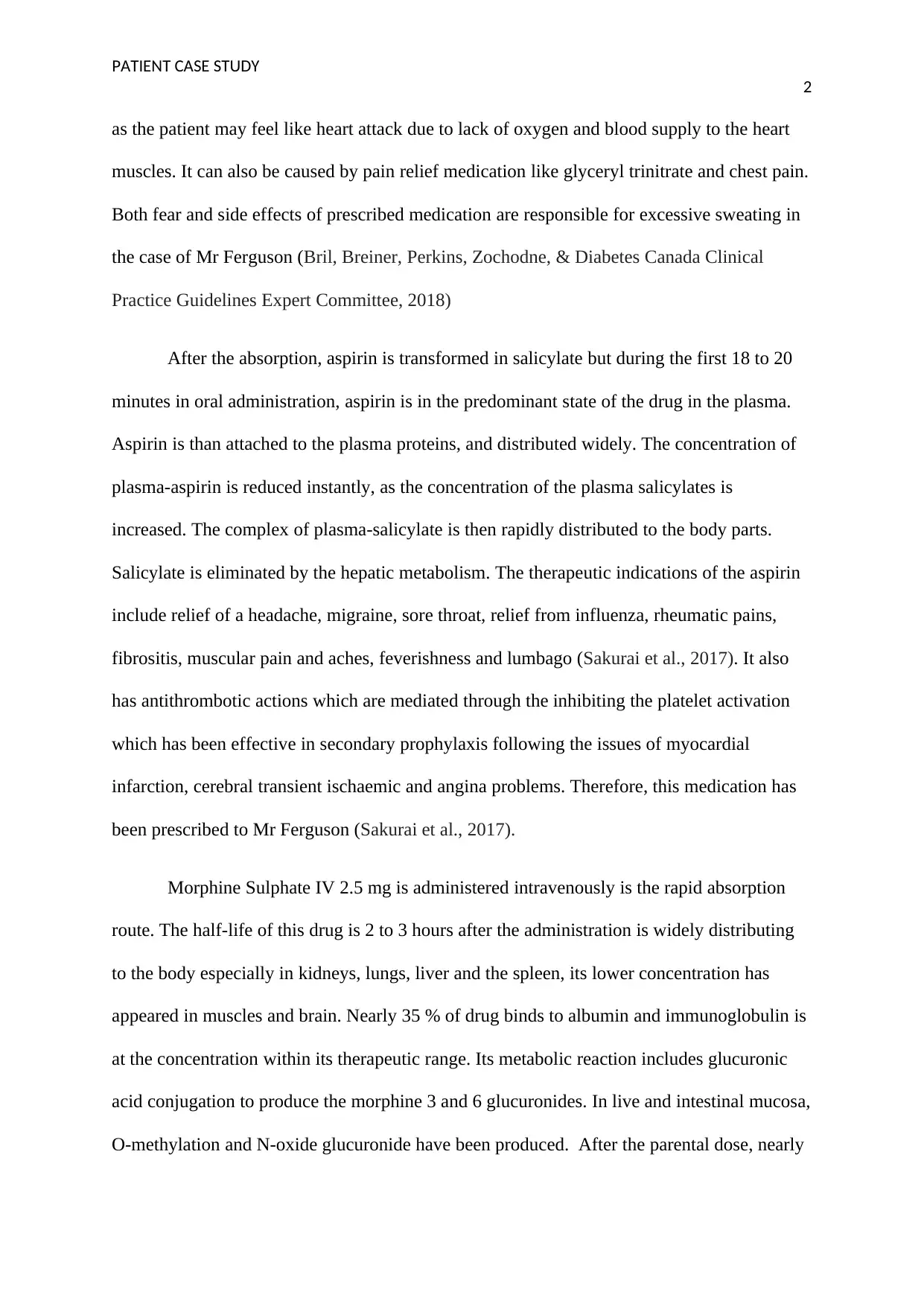
PATIENT CASE STUDY
2
as the patient may feel like heart attack due to lack of oxygen and blood supply to the heart
muscles. It can also be caused by pain relief medication like glyceryl trinitrate and chest pain.
Both fear and side effects of prescribed medication are responsible for excessive sweating in
the case of Mr Ferguson (Bril, Breiner, Perkins, Zochodne, & Diabetes Canada Clinical
Practice Guidelines Expert Committee, 2018)
After the absorption, aspirin is transformed in salicylate but during the first 18 to 20
minutes in oral administration, aspirin is in the predominant state of the drug in the plasma.
Aspirin is than attached to the plasma proteins, and distributed widely. The concentration of
plasma-aspirin is reduced instantly, as the concentration of the plasma salicylates is
increased. The complex of plasma-salicylate is then rapidly distributed to the body parts.
Salicylate is eliminated by the hepatic metabolism. The therapeutic indications of the aspirin
include relief of a headache, migraine, sore throat, relief from influenza, rheumatic pains,
fibrositis, muscular pain and aches, feverishness and lumbago (Sakurai et al., 2017). It also
has antithrombotic actions which are mediated through the inhibiting the platelet activation
which has been effective in secondary prophylaxis following the issues of myocardial
infarction, cerebral transient ischaemic and angina problems. Therefore, this medication has
been prescribed to Mr Ferguson (Sakurai et al., 2017).
Morphine Sulphate IV 2.5 mg is administered intravenously is the rapid absorption
route. The half-life of this drug is 2 to 3 hours after the administration is widely distributing
to the body especially in kidneys, lungs, liver and the spleen, its lower concentration has
appeared in muscles and brain. Nearly 35 % of drug binds to albumin and immunoglobulin is
at the concentration within its therapeutic range. Its metabolic reaction includes glucuronic
acid conjugation to produce the morphine 3 and 6 glucuronides. In live and intestinal mucosa,
O-methylation and N-oxide glucuronide have been produced. After the parental dose, nearly
2
as the patient may feel like heart attack due to lack of oxygen and blood supply to the heart
muscles. It can also be caused by pain relief medication like glyceryl trinitrate and chest pain.
Both fear and side effects of prescribed medication are responsible for excessive sweating in
the case of Mr Ferguson (Bril, Breiner, Perkins, Zochodne, & Diabetes Canada Clinical
Practice Guidelines Expert Committee, 2018)
After the absorption, aspirin is transformed in salicylate but during the first 18 to 20
minutes in oral administration, aspirin is in the predominant state of the drug in the plasma.
Aspirin is than attached to the plasma proteins, and distributed widely. The concentration of
plasma-aspirin is reduced instantly, as the concentration of the plasma salicylates is
increased. The complex of plasma-salicylate is then rapidly distributed to the body parts.
Salicylate is eliminated by the hepatic metabolism. The therapeutic indications of the aspirin
include relief of a headache, migraine, sore throat, relief from influenza, rheumatic pains,
fibrositis, muscular pain and aches, feverishness and lumbago (Sakurai et al., 2017). It also
has antithrombotic actions which are mediated through the inhibiting the platelet activation
which has been effective in secondary prophylaxis following the issues of myocardial
infarction, cerebral transient ischaemic and angina problems. Therefore, this medication has
been prescribed to Mr Ferguson (Sakurai et al., 2017).
Morphine Sulphate IV 2.5 mg is administered intravenously is the rapid absorption
route. The half-life of this drug is 2 to 3 hours after the administration is widely distributing
to the body especially in kidneys, lungs, liver and the spleen, its lower concentration has
appeared in muscles and brain. Nearly 35 % of drug binds to albumin and immunoglobulin is
at the concentration within its therapeutic range. Its metabolic reaction includes glucuronic
acid conjugation to produce the morphine 3 and 6 glucuronides. In live and intestinal mucosa,
O-methylation and N-oxide glucuronide have been produced. After the parental dose, nearly
⊘ This is a preview!⊘
Do you want full access?
Subscribe today to unlock all pages.

Trusted by 1+ million students worldwide
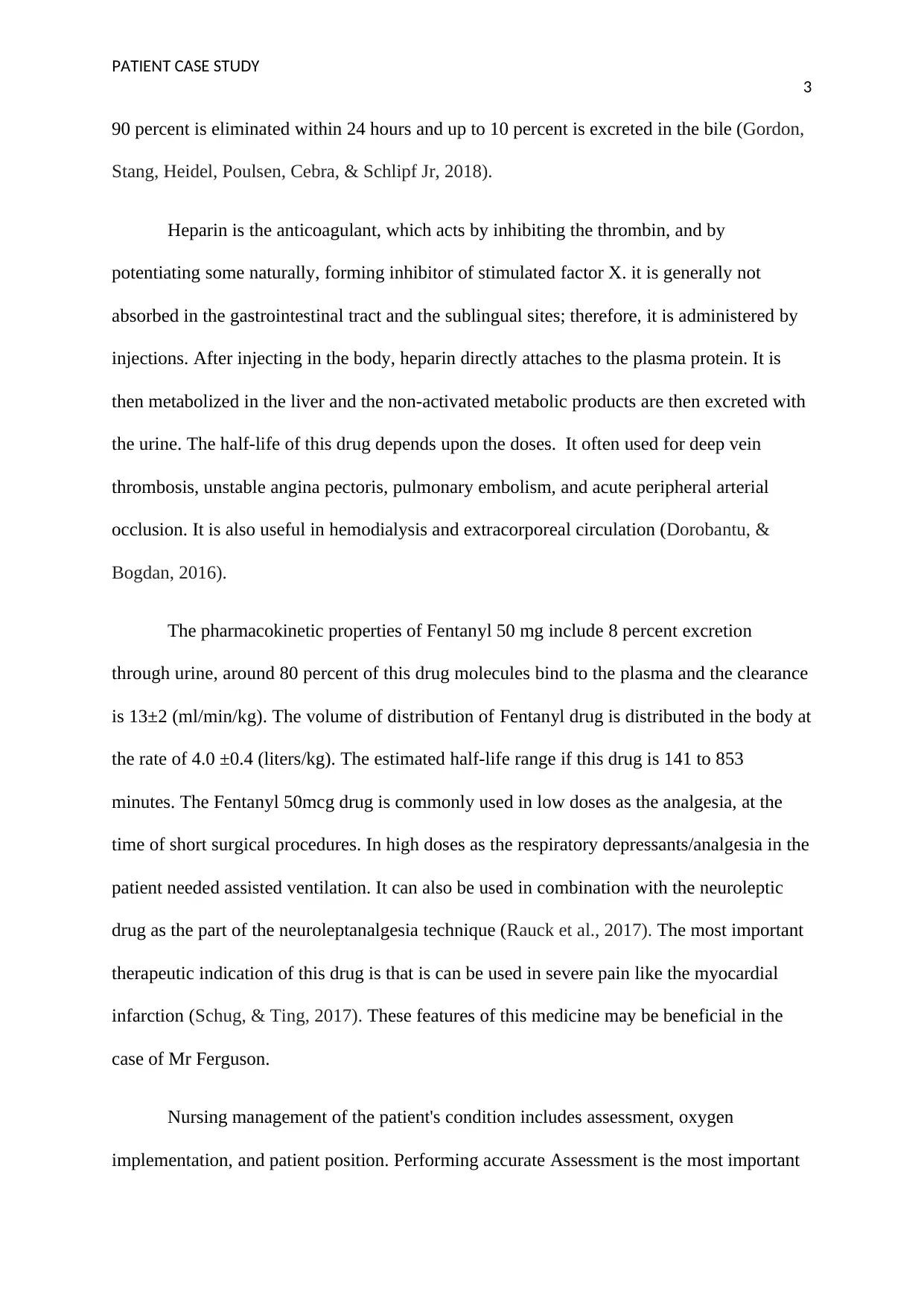
PATIENT CASE STUDY
3
90 percent is eliminated within 24 hours and up to 10 percent is excreted in the bile (Gordon,
Stang, Heidel, Poulsen, Cebra, & Schlipf Jr, 2018).
Heparin is the anticoagulant, which acts by inhibiting the thrombin, and by
potentiating some naturally, forming inhibitor of stimulated factor X. it is generally not
absorbed in the gastrointestinal tract and the sublingual sites; therefore, it is administered by
injections. After injecting in the body, heparin directly attaches to the plasma protein. It is
then metabolized in the liver and the non-activated metabolic products are then excreted with
the urine. The half-life of this drug depends upon the doses. It often used for deep vein
thrombosis, unstable angina pectoris, pulmonary embolism, and acute peripheral arterial
occlusion. It is also useful in hemodialysis and extracorporeal circulation (Dorobantu, &
Bogdan, 2016).
The pharmacokinetic properties of Fentanyl 50 mg include 8 percent excretion
through urine, around 80 percent of this drug molecules bind to the plasma and the clearance
is 13±2 (ml/min/kg). The volume of distribution of Fentanyl drug is distributed in the body at
the rate of 4.0 ±0.4 (liters/kg). The estimated half-life range if this drug is 141 to 853
minutes. The Fentanyl 50mcg drug is commonly used in low doses as the analgesia, at the
time of short surgical procedures. In high doses as the respiratory depressants/analgesia in the
patient needed assisted ventilation. It can also be used in combination with the neuroleptic
drug as the part of the neuroleptanalgesia technique (Rauck et al., 2017). The most important
therapeutic indication of this drug is that is can be used in severe pain like the myocardial
infarction (Schug, & Ting, 2017). These features of this medicine may be beneficial in the
case of Mr Ferguson.
Nursing management of the patient's condition includes assessment, oxygen
implementation, and patient position. Performing accurate Assessment is the most important
3
90 percent is eliminated within 24 hours and up to 10 percent is excreted in the bile (Gordon,
Stang, Heidel, Poulsen, Cebra, & Schlipf Jr, 2018).
Heparin is the anticoagulant, which acts by inhibiting the thrombin, and by
potentiating some naturally, forming inhibitor of stimulated factor X. it is generally not
absorbed in the gastrointestinal tract and the sublingual sites; therefore, it is administered by
injections. After injecting in the body, heparin directly attaches to the plasma protein. It is
then metabolized in the liver and the non-activated metabolic products are then excreted with
the urine. The half-life of this drug depends upon the doses. It often used for deep vein
thrombosis, unstable angina pectoris, pulmonary embolism, and acute peripheral arterial
occlusion. It is also useful in hemodialysis and extracorporeal circulation (Dorobantu, &
Bogdan, 2016).
The pharmacokinetic properties of Fentanyl 50 mg include 8 percent excretion
through urine, around 80 percent of this drug molecules bind to the plasma and the clearance
is 13±2 (ml/min/kg). The volume of distribution of Fentanyl drug is distributed in the body at
the rate of 4.0 ±0.4 (liters/kg). The estimated half-life range if this drug is 141 to 853
minutes. The Fentanyl 50mcg drug is commonly used in low doses as the analgesia, at the
time of short surgical procedures. In high doses as the respiratory depressants/analgesia in the
patient needed assisted ventilation. It can also be used in combination with the neuroleptic
drug as the part of the neuroleptanalgesia technique (Rauck et al., 2017). The most important
therapeutic indication of this drug is that is can be used in severe pain like the myocardial
infarction (Schug, & Ting, 2017). These features of this medicine may be beneficial in the
case of Mr Ferguson.
Nursing management of the patient's condition includes assessment, oxygen
implementation, and patient position. Performing accurate Assessment is the most important
Paraphrase This Document
Need a fresh take? Get an instant paraphrase of this document with our AI Paraphraser
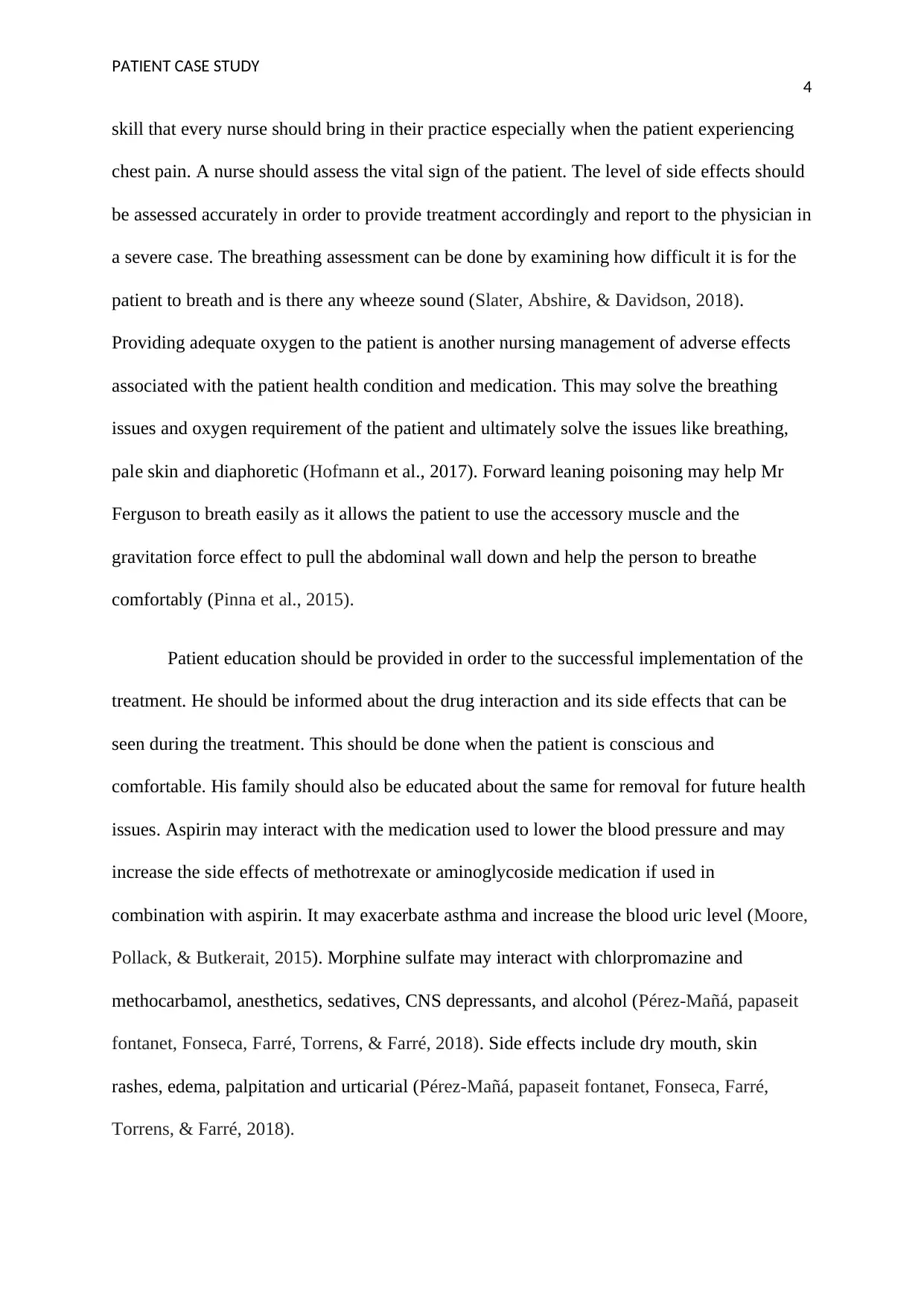
PATIENT CASE STUDY
4
skill that every nurse should bring in their practice especially when the patient experiencing
chest pain. A nurse should assess the vital sign of the patient. The level of side effects should
be assessed accurately in order to provide treatment accordingly and report to the physician in
a severe case. The breathing assessment can be done by examining how difficult it is for the
patient to breath and is there any wheeze sound (Slater, Abshire, & Davidson, 2018).
Providing adequate oxygen to the patient is another nursing management of adverse effects
associated with the patient health condition and medication. This may solve the breathing
issues and oxygen requirement of the patient and ultimately solve the issues like breathing,
pale skin and diaphoretic (Hofmann et al., 2017). Forward leaning poisoning may help Mr
Ferguson to breath easily as it allows the patient to use the accessory muscle and the
gravitation force effect to pull the abdominal wall down and help the person to breathe
comfortably (Pinna et al., 2015).
Patient education should be provided in order to the successful implementation of the
treatment. He should be informed about the drug interaction and its side effects that can be
seen during the treatment. This should be done when the patient is conscious and
comfortable. His family should also be educated about the same for removal for future health
issues. Aspirin may interact with the medication used to lower the blood pressure and may
increase the side effects of methotrexate or aminoglycoside medication if used in
combination with aspirin. It may exacerbate asthma and increase the blood uric level (Moore,
Pollack, & Butkerait, 2015). Morphine sulfate may interact with chlorpromazine and
methocarbamol, anesthetics, sedatives, CNS depressants, and alcohol (Pérez-Mañá, papaseit
fontanet, Fonseca, Farré, Torrens, & Farré, 2018). Side effects include dry mouth, skin
rashes, edema, palpitation and urticarial (Pérez-Mañá, papaseit fontanet, Fonseca, Farré,
Torrens, & Farré, 2018).
4
skill that every nurse should bring in their practice especially when the patient experiencing
chest pain. A nurse should assess the vital sign of the patient. The level of side effects should
be assessed accurately in order to provide treatment accordingly and report to the physician in
a severe case. The breathing assessment can be done by examining how difficult it is for the
patient to breath and is there any wheeze sound (Slater, Abshire, & Davidson, 2018).
Providing adequate oxygen to the patient is another nursing management of adverse effects
associated with the patient health condition and medication. This may solve the breathing
issues and oxygen requirement of the patient and ultimately solve the issues like breathing,
pale skin and diaphoretic (Hofmann et al., 2017). Forward leaning poisoning may help Mr
Ferguson to breath easily as it allows the patient to use the accessory muscle and the
gravitation force effect to pull the abdominal wall down and help the person to breathe
comfortably (Pinna et al., 2015).
Patient education should be provided in order to the successful implementation of the
treatment. He should be informed about the drug interaction and its side effects that can be
seen during the treatment. This should be done when the patient is conscious and
comfortable. His family should also be educated about the same for removal for future health
issues. Aspirin may interact with the medication used to lower the blood pressure and may
increase the side effects of methotrexate or aminoglycoside medication if used in
combination with aspirin. It may exacerbate asthma and increase the blood uric level (Moore,
Pollack, & Butkerait, 2015). Morphine sulfate may interact with chlorpromazine and
methocarbamol, anesthetics, sedatives, CNS depressants, and alcohol (Pérez-Mañá, papaseit
fontanet, Fonseca, Farré, Torrens, & Farré, 2018). Side effects include dry mouth, skin
rashes, edema, palpitation and urticarial (Pérez-Mañá, papaseit fontanet, Fonseca, Farré,
Torrens, & Farré, 2018).
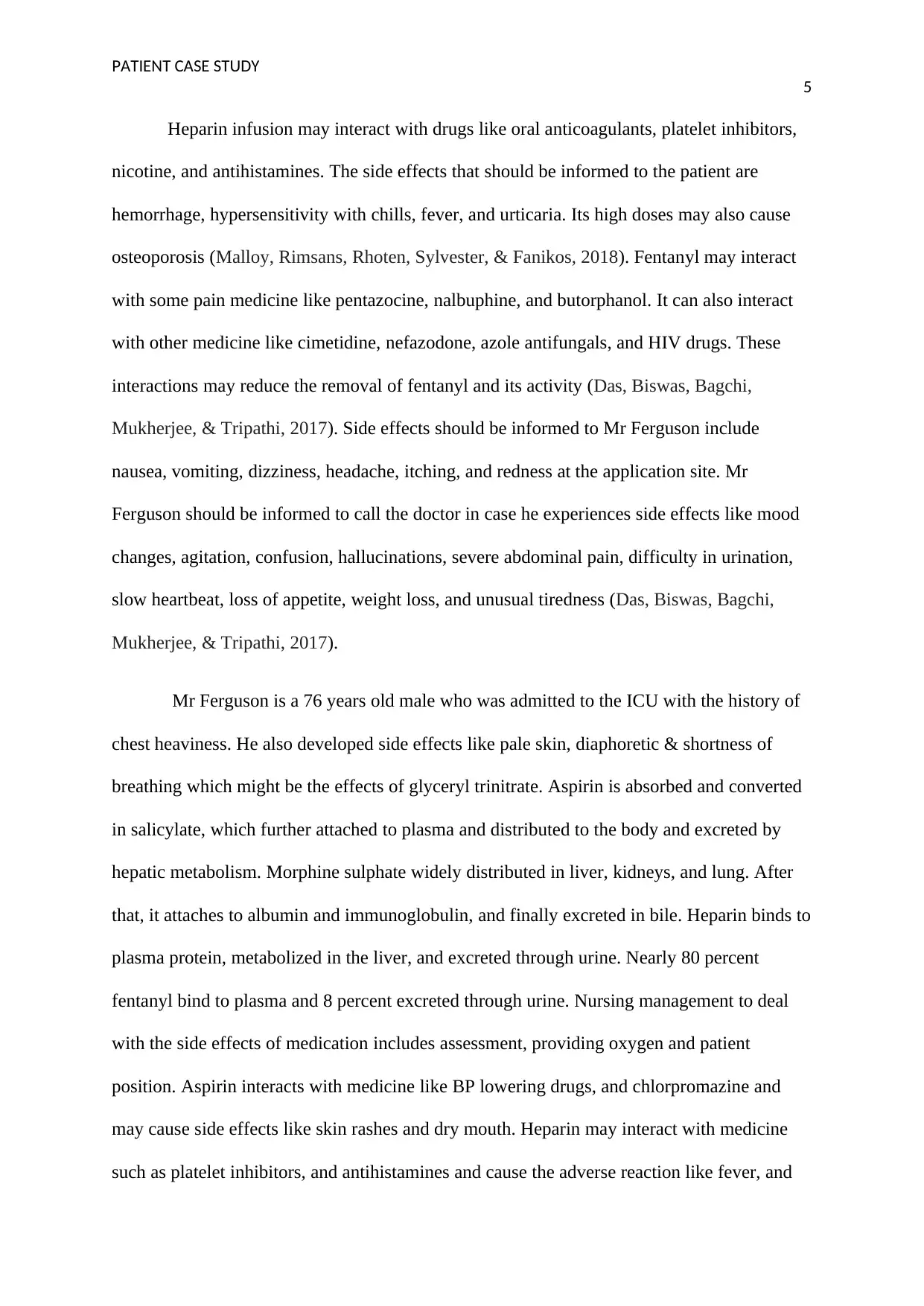
PATIENT CASE STUDY
5
Heparin infusion may interact with drugs like oral anticoagulants, platelet inhibitors,
nicotine, and antihistamines. The side effects that should be informed to the patient are
hemorrhage, hypersensitivity with chills, fever, and urticaria. Its high doses may also cause
osteoporosis (Malloy, Rimsans, Rhoten, Sylvester, & Fanikos, 2018). Fentanyl may interact
with some pain medicine like pentazocine, nalbuphine, and butorphanol. It can also interact
with other medicine like cimetidine, nefazodone, azole antifungals, and HIV drugs. These
interactions may reduce the removal of fentanyl and its activity (Das, Biswas, Bagchi,
Mukherjee, & Tripathi, 2017). Side effects should be informed to Mr Ferguson include
nausea, vomiting, dizziness, headache, itching, and redness at the application site. Mr
Ferguson should be informed to call the doctor in case he experiences side effects like mood
changes, agitation, confusion, hallucinations, severe abdominal pain, difficulty in urination,
slow heartbeat, loss of appetite, weight loss, and unusual tiredness (Das, Biswas, Bagchi,
Mukherjee, & Tripathi, 2017).
Mr Ferguson is a 76 years old male who was admitted to the ICU with the history of
chest heaviness. He also developed side effects like pale skin, diaphoretic & shortness of
breathing which might be the effects of glyceryl trinitrate. Aspirin is absorbed and converted
in salicylate, which further attached to plasma and distributed to the body and excreted by
hepatic metabolism. Morphine sulphate widely distributed in liver, kidneys, and lung. After
that, it attaches to albumin and immunoglobulin, and finally excreted in bile. Heparin binds to
plasma protein, metabolized in the liver, and excreted through urine. Nearly 80 percent
fentanyl bind to plasma and 8 percent excreted through urine. Nursing management to deal
with the side effects of medication includes assessment, providing oxygen and patient
position. Aspirin interacts with medicine like BP lowering drugs, and chlorpromazine and
may cause side effects like skin rashes and dry mouth. Heparin may interact with medicine
such as platelet inhibitors, and antihistamines and cause the adverse reaction like fever, and
5
Heparin infusion may interact with drugs like oral anticoagulants, platelet inhibitors,
nicotine, and antihistamines. The side effects that should be informed to the patient are
hemorrhage, hypersensitivity with chills, fever, and urticaria. Its high doses may also cause
osteoporosis (Malloy, Rimsans, Rhoten, Sylvester, & Fanikos, 2018). Fentanyl may interact
with some pain medicine like pentazocine, nalbuphine, and butorphanol. It can also interact
with other medicine like cimetidine, nefazodone, azole antifungals, and HIV drugs. These
interactions may reduce the removal of fentanyl and its activity (Das, Biswas, Bagchi,
Mukherjee, & Tripathi, 2017). Side effects should be informed to Mr Ferguson include
nausea, vomiting, dizziness, headache, itching, and redness at the application site. Mr
Ferguson should be informed to call the doctor in case he experiences side effects like mood
changes, agitation, confusion, hallucinations, severe abdominal pain, difficulty in urination,
slow heartbeat, loss of appetite, weight loss, and unusual tiredness (Das, Biswas, Bagchi,
Mukherjee, & Tripathi, 2017).
Mr Ferguson is a 76 years old male who was admitted to the ICU with the history of
chest heaviness. He also developed side effects like pale skin, diaphoretic & shortness of
breathing which might be the effects of glyceryl trinitrate. Aspirin is absorbed and converted
in salicylate, which further attached to plasma and distributed to the body and excreted by
hepatic metabolism. Morphine sulphate widely distributed in liver, kidneys, and lung. After
that, it attaches to albumin and immunoglobulin, and finally excreted in bile. Heparin binds to
plasma protein, metabolized in the liver, and excreted through urine. Nearly 80 percent
fentanyl bind to plasma and 8 percent excreted through urine. Nursing management to deal
with the side effects of medication includes assessment, providing oxygen and patient
position. Aspirin interacts with medicine like BP lowering drugs, and chlorpromazine and
may cause side effects like skin rashes and dry mouth. Heparin may interact with medicine
such as platelet inhibitors, and antihistamines and cause the adverse reaction like fever, and
⊘ This is a preview!⊘
Do you want full access?
Subscribe today to unlock all pages.

Trusted by 1+ million students worldwide
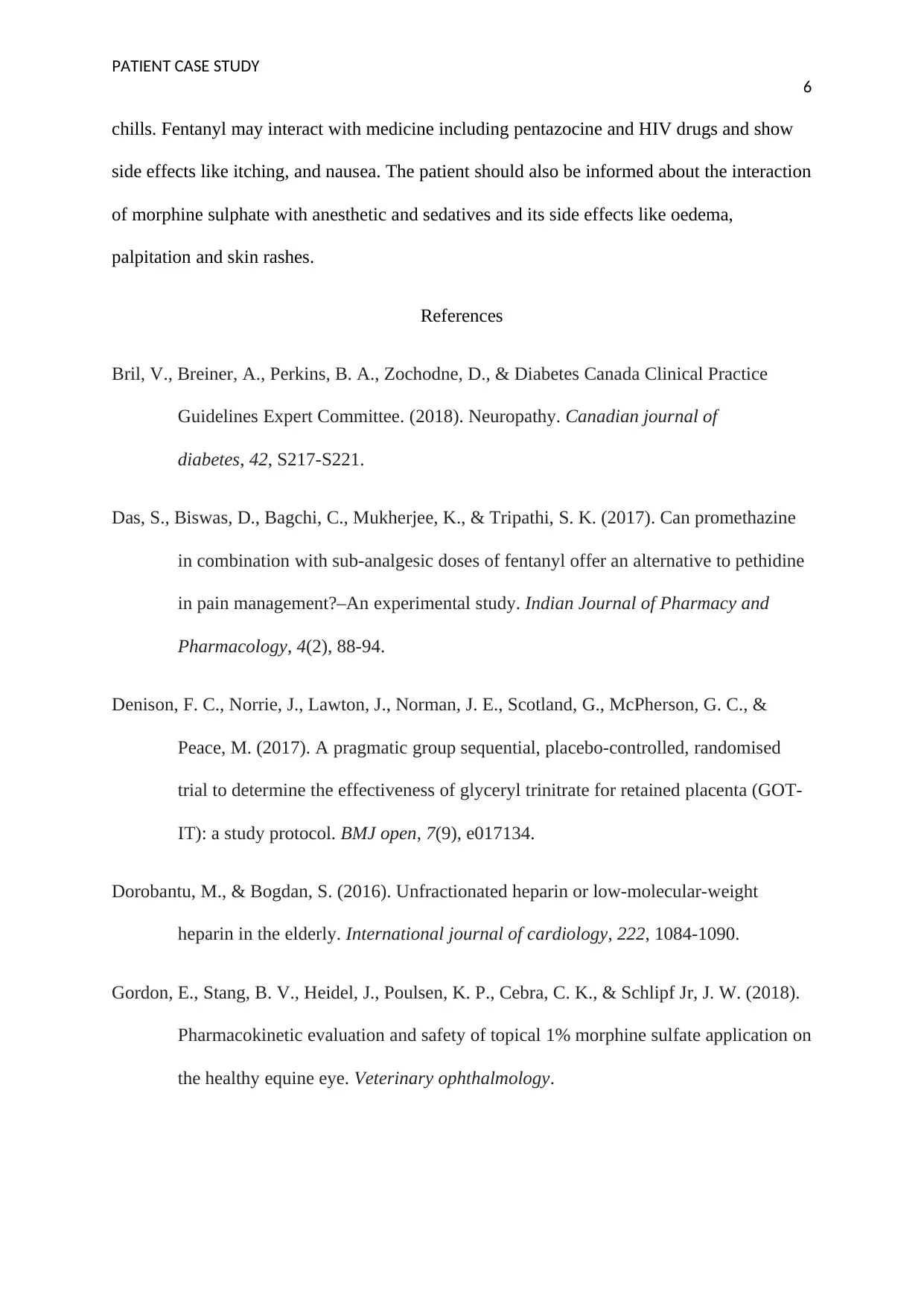
PATIENT CASE STUDY
6
chills. Fentanyl may interact with medicine including pentazocine and HIV drugs and show
side effects like itching, and nausea. The patient should also be informed about the interaction
of morphine sulphate with anesthetic and sedatives and its side effects like oedema,
palpitation and skin rashes.
References
Bril, V., Breiner, A., Perkins, B. A., Zochodne, D., & Diabetes Canada Clinical Practice
Guidelines Expert Committee. (2018). Neuropathy. Canadian journal of
diabetes, 42, S217-S221.
Das, S., Biswas, D., Bagchi, C., Mukherjee, K., & Tripathi, S. K. (2017). Can promethazine
in combination with sub-analgesic doses of fentanyl offer an alternative to pethidine
in pain management?–An experimental study. Indian Journal of Pharmacy and
Pharmacology, 4(2), 88-94.
Denison, F. C., Norrie, J., Lawton, J., Norman, J. E., Scotland, G., McPherson, G. C., &
Peace, M. (2017). A pragmatic group sequential, placebo-controlled, randomised
trial to determine the effectiveness of glyceryl trinitrate for retained placenta (GOT-
IT): a study protocol. BMJ open, 7(9), e017134.
Dorobantu, M., & Bogdan, S. (2016). Unfractionated heparin or low-molecular-weight
heparin in the elderly. International journal of cardiology, 222, 1084-1090.
Gordon, E., Stang, B. V., Heidel, J., Poulsen, K. P., Cebra, C. K., & Schlipf Jr, J. W. (2018).
Pharmacokinetic evaluation and safety of topical 1% morphine sulfate application on
the healthy equine eye. Veterinary ophthalmology.
6
chills. Fentanyl may interact with medicine including pentazocine and HIV drugs and show
side effects like itching, and nausea. The patient should also be informed about the interaction
of morphine sulphate with anesthetic and sedatives and its side effects like oedema,
palpitation and skin rashes.
References
Bril, V., Breiner, A., Perkins, B. A., Zochodne, D., & Diabetes Canada Clinical Practice
Guidelines Expert Committee. (2018). Neuropathy. Canadian journal of
diabetes, 42, S217-S221.
Das, S., Biswas, D., Bagchi, C., Mukherjee, K., & Tripathi, S. K. (2017). Can promethazine
in combination with sub-analgesic doses of fentanyl offer an alternative to pethidine
in pain management?–An experimental study. Indian Journal of Pharmacy and
Pharmacology, 4(2), 88-94.
Denison, F. C., Norrie, J., Lawton, J., Norman, J. E., Scotland, G., McPherson, G. C., &
Peace, M. (2017). A pragmatic group sequential, placebo-controlled, randomised
trial to determine the effectiveness of glyceryl trinitrate for retained placenta (GOT-
IT): a study protocol. BMJ open, 7(9), e017134.
Dorobantu, M., & Bogdan, S. (2016). Unfractionated heparin or low-molecular-weight
heparin in the elderly. International journal of cardiology, 222, 1084-1090.
Gordon, E., Stang, B. V., Heidel, J., Poulsen, K. P., Cebra, C. K., & Schlipf Jr, J. W. (2018).
Pharmacokinetic evaluation and safety of topical 1% morphine sulfate application on
the healthy equine eye. Veterinary ophthalmology.
Paraphrase This Document
Need a fresh take? Get an instant paraphrase of this document with our AI Paraphraser
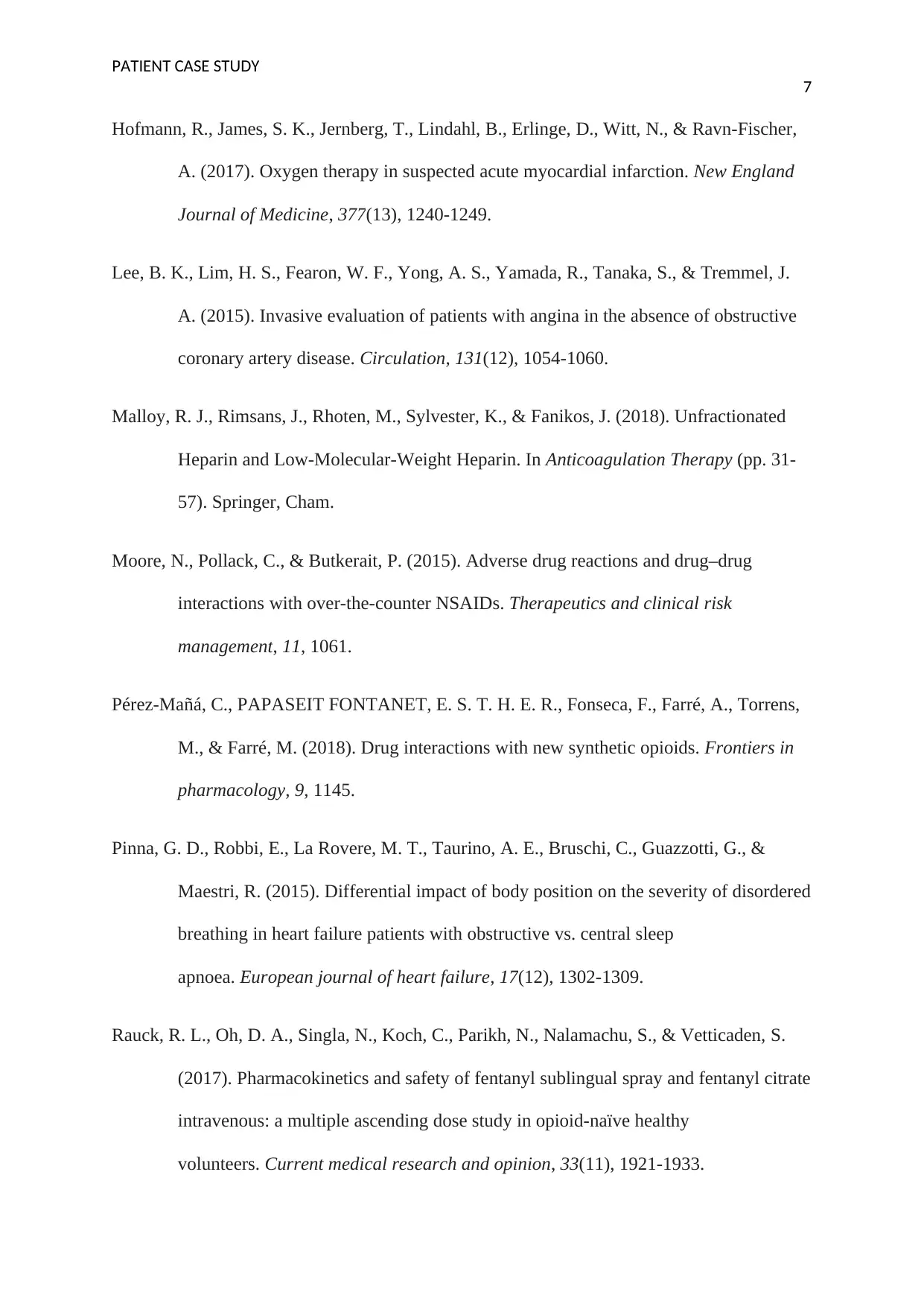
PATIENT CASE STUDY
7
Hofmann, R., James, S. K., Jernberg, T., Lindahl, B., Erlinge, D., Witt, N., & Ravn-Fischer,
A. (2017). Oxygen therapy in suspected acute myocardial infarction. New England
Journal of Medicine, 377(13), 1240-1249.
Lee, B. K., Lim, H. S., Fearon, W. F., Yong, A. S., Yamada, R., Tanaka, S., & Tremmel, J.
A. (2015). Invasive evaluation of patients with angina in the absence of obstructive
coronary artery disease. Circulation, 131(12), 1054-1060.
Malloy, R. J., Rimsans, J., Rhoten, M., Sylvester, K., & Fanikos, J. (2018). Unfractionated
Heparin and Low-Molecular-Weight Heparin. In Anticoagulation Therapy (pp. 31-
57). Springer, Cham.
Moore, N., Pollack, C., & Butkerait, P. (2015). Adverse drug reactions and drug–drug
interactions with over-the-counter NSAIDs. Therapeutics and clinical risk
management, 11, 1061.
Pérez-Mañá, C., PAPASEIT FONTANET, E. S. T. H. E. R., Fonseca, F., Farré, A., Torrens,
M., & Farré, M. (2018). Drug interactions with new synthetic opioids. Frontiers in
pharmacology, 9, 1145.
Pinna, G. D., Robbi, E., La Rovere, M. T., Taurino, A. E., Bruschi, C., Guazzotti, G., &
Maestri, R. (2015). Differential impact of body position on the severity of disordered
breathing in heart failure patients with obstructive vs. central sleep
apnoea. European journal of heart failure, 17(12), 1302-1309.
Rauck, R. L., Oh, D. A., Singla, N., Koch, C., Parikh, N., Nalamachu, S., & Vetticaden, S.
(2017). Pharmacokinetics and safety of fentanyl sublingual spray and fentanyl citrate
intravenous: a multiple ascending dose study in opioid-naïve healthy
volunteers. Current medical research and opinion, 33(11), 1921-1933.
7
Hofmann, R., James, S. K., Jernberg, T., Lindahl, B., Erlinge, D., Witt, N., & Ravn-Fischer,
A. (2017). Oxygen therapy in suspected acute myocardial infarction. New England
Journal of Medicine, 377(13), 1240-1249.
Lee, B. K., Lim, H. S., Fearon, W. F., Yong, A. S., Yamada, R., Tanaka, S., & Tremmel, J.
A. (2015). Invasive evaluation of patients with angina in the absence of obstructive
coronary artery disease. Circulation, 131(12), 1054-1060.
Malloy, R. J., Rimsans, J., Rhoten, M., Sylvester, K., & Fanikos, J. (2018). Unfractionated
Heparin and Low-Molecular-Weight Heparin. In Anticoagulation Therapy (pp. 31-
57). Springer, Cham.
Moore, N., Pollack, C., & Butkerait, P. (2015). Adverse drug reactions and drug–drug
interactions with over-the-counter NSAIDs. Therapeutics and clinical risk
management, 11, 1061.
Pérez-Mañá, C., PAPASEIT FONTANET, E. S. T. H. E. R., Fonseca, F., Farré, A., Torrens,
M., & Farré, M. (2018). Drug interactions with new synthetic opioids. Frontiers in
pharmacology, 9, 1145.
Pinna, G. D., Robbi, E., La Rovere, M. T., Taurino, A. E., Bruschi, C., Guazzotti, G., &
Maestri, R. (2015). Differential impact of body position on the severity of disordered
breathing in heart failure patients with obstructive vs. central sleep
apnoea. European journal of heart failure, 17(12), 1302-1309.
Rauck, R. L., Oh, D. A., Singla, N., Koch, C., Parikh, N., Nalamachu, S., & Vetticaden, S.
(2017). Pharmacokinetics and safety of fentanyl sublingual spray and fentanyl citrate
intravenous: a multiple ascending dose study in opioid-naïve healthy
volunteers. Current medical research and opinion, 33(11), 1921-1933.
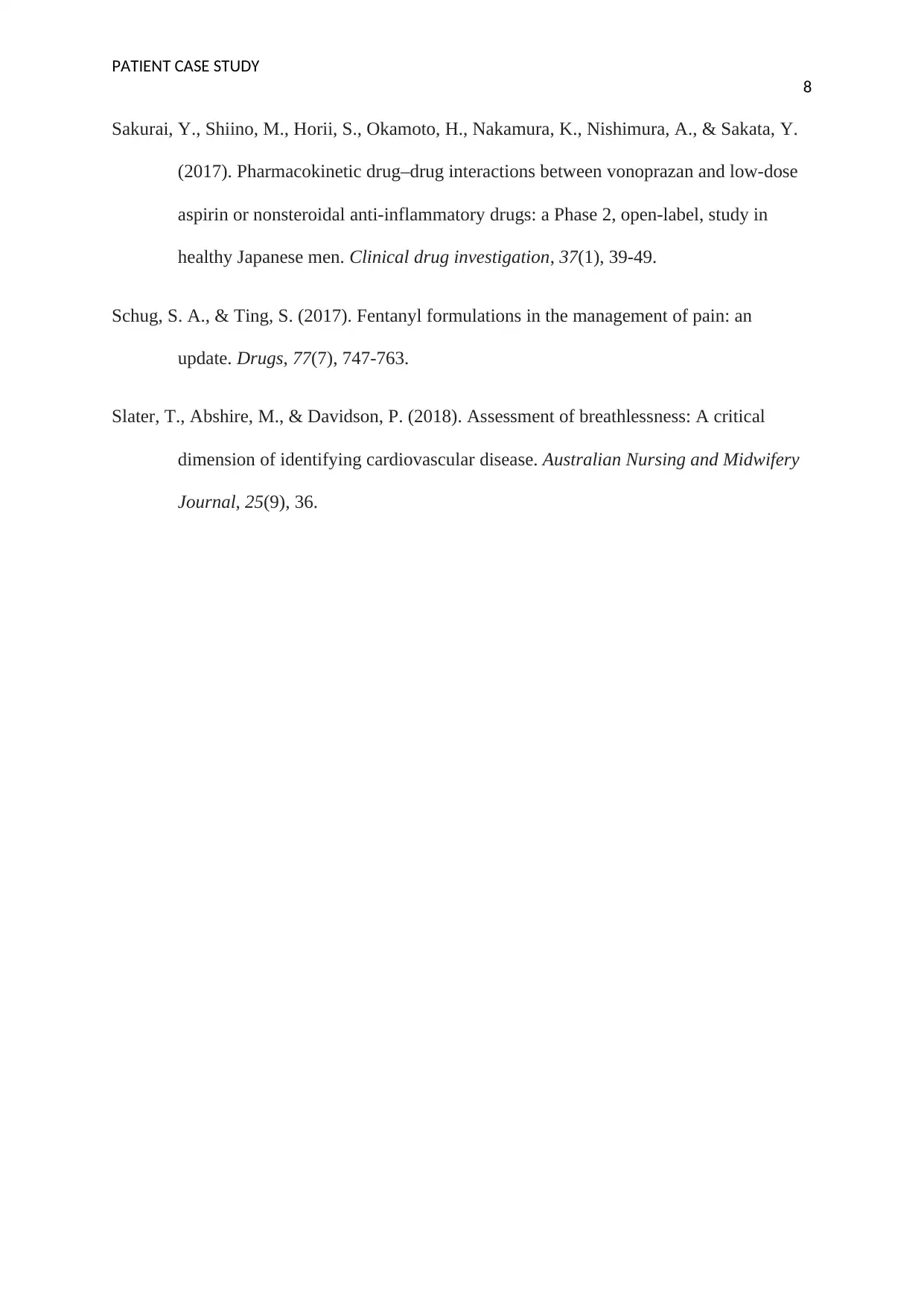
PATIENT CASE STUDY
8
Sakurai, Y., Shiino, M., Horii, S., Okamoto, H., Nakamura, K., Nishimura, A., & Sakata, Y.
(2017). Pharmacokinetic drug–drug interactions between vonoprazan and low-dose
aspirin or nonsteroidal anti-inflammatory drugs: a Phase 2, open-label, study in
healthy Japanese men. Clinical drug investigation, 37(1), 39-49.
Schug, S. A., & Ting, S. (2017). Fentanyl formulations in the management of pain: an
update. Drugs, 77(7), 747-763.
Slater, T., Abshire, M., & Davidson, P. (2018). Assessment of breathlessness: A critical
dimension of identifying cardiovascular disease. Australian Nursing and Midwifery
Journal, 25(9), 36.
8
Sakurai, Y., Shiino, M., Horii, S., Okamoto, H., Nakamura, K., Nishimura, A., & Sakata, Y.
(2017). Pharmacokinetic drug–drug interactions between vonoprazan and low-dose
aspirin or nonsteroidal anti-inflammatory drugs: a Phase 2, open-label, study in
healthy Japanese men. Clinical drug investigation, 37(1), 39-49.
Schug, S. A., & Ting, S. (2017). Fentanyl formulations in the management of pain: an
update. Drugs, 77(7), 747-763.
Slater, T., Abshire, M., & Davidson, P. (2018). Assessment of breathlessness: A critical
dimension of identifying cardiovascular disease. Australian Nursing and Midwifery
Journal, 25(9), 36.
⊘ This is a preview!⊘
Do you want full access?
Subscribe today to unlock all pages.

Trusted by 1+ million students worldwide
1 out of 9
Related Documents
Your All-in-One AI-Powered Toolkit for Academic Success.
+13062052269
info@desklib.com
Available 24*7 on WhatsApp / Email
![[object Object]](/_next/static/media/star-bottom.7253800d.svg)
Unlock your academic potential
Copyright © 2020–2025 A2Z Services. All Rights Reserved. Developed and managed by ZUCOL.





